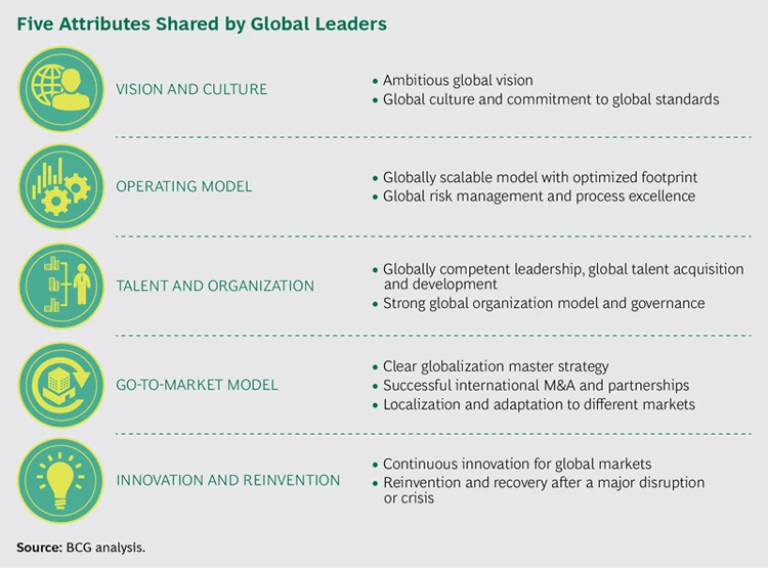This article is an excerpt from Global Leaders, Challengers, and Champions: The Engines of Emerging Markets (BCG report, June 2016)
2016 BCG Global Challengers
- Global Leaders, Challengers, and Champions
- Meet the New Challengers
- How Challengers Have Achieved Global Leadership
- Competing for the Future
As their name suggests, the global challengers have unfinished business to complete. They are on a path to become top companies in their industry, but there is no guarantee that they will get there. On the other hand, companies that we call "graduates" have reached that peak. These 19 former global challengers are virtually indistinguishable from multinationals. What separates those companies from the challengers?
Five Under-the-Hood Success Factors
In seeking to understand the difference between challengers and graduates, we uncovered five “under the hood” attributes that separate global leaders from the pack. Collectively, they constitute a winning combination that is greater than the sum of its parts. (See the exhibit below.) Indeed, all of our 19 graduates have acquired at least four of these five attributes.
Vision and Culture. In the case of all 19 graduates, their vision is easy to describe and see in action. América Móvil aspires to be the fastest-growing telecommunications company in the world, while Tata Motors’ ambition is to be the car company most admired by customers, employees, and shareholders. Johnson Electric aims to be the most innovative and reliable supplier of motors and motion systems. Many former global challengers also articulated a compelling vision. But they failed to create a culture that unified the company and amplified individual effort and achievement.
Operating Model. The operating models of global leaders are built to go global and to be adaptive. They are not modified versions of the model designed for the company’s home market. Global leaders build global processes, especially for risk management and other core activities, but are willing to bend the rules so that local markets can make adaptations. Hindalco, for example, has deliberately created a portfolio of high- and low-margin products in order to provide a buffer against ups and downs in the economy.
Talent and Organization. Talent and larger organizational issues are often what distinguish global leaders, since the demand for great people is so intense, especially in emerging markets. Global leaders build global leadership and talent programs, rotate top people through geographies, and create opportunities for star talent outside of the home market. They build an employer-of-choice brand in key recruiting markets. They know how to integrate talent and retain key aspects of their culture when they acquire other companies. They create cost-effective training engines for line workers and middle managers. Tata Consultancy Services, for example, has learned how to scale its recruiting, onboarding, and training engines for the 50,000 or more employees that join the company each year. Such companies as Lenovo and Emirates Airlines have created a diverse and international workforce at all levels.
Go-to-Market Model. Global leaders understand how to be successful in many markets. They make smart local acquisitions and develop local partnerships to fill in the gaps in their coverage, product portfolio, or distribution networks. Meat processer JBS, for example, has created strategic partnerships in key geographies, established direct-sales teams, and located production facilities in low-cost countries.
Innovation and Reinvention. Global leaders are continually innovating and, when necessary, reinventing themselves to stay relevant. Li & Fung will create and shutter business units as necessary. Recognizing that beer tastes are regional, SABMiller uses local ingredients in its breweries. In Africa, for example, it offers many bottle and can sizes and uses local crops like sorghum to brew affordable beer.
Winners Versus Losers
To better understand these factors, we examined two pairs of companies in two industries. They started in similar positions of strength, but their fortunes took dramatically different turns.
In one case, a large industrial goods conglomerate took advantage of a favorable cost structure, strategic M&A, and strong leadership to rise to the top of its sector. Managers knew how to execute and how to work with local partners in new markets. The other company focused on achieving efficiency and reaching production targets, but management conflicts and low-performing assets kept it from continuing on its growth path. The first company is now a global leader. The second has fallen off the global challenger list.
The companies in the second pair are both involved in similar technology, media, and telecom businesses. One invested heavily in innovation, especially localized R&D. It actively developed new technologies, both in-house and in partnership with outsiders. It developed modern, agile ways of working. The other company remained true to its command-and-control bureaucratic structure, which led to sluggish decision making and a lack of local adaptation. Its innovation strategy was reactive, responding to requests from customers, rather than forward looking. Not surprisingly, the paths of these two companies also diverged—global leadership for one, falling revenues for the other.
While graduate companies share most of the five attributes described above, they did not all achieve success and competitive advantage in the same way. We have identified their three primary strategic approaches.
- They rely on strategic M&A and world-class integration to create long-term value. Mexico’s Cemex in cement, South Arica’s SABMiller in beer, and Mexico’s Alfa have successfully integrated companies with diverse cultures and spread best practices.
- They scale and replicate a successful business model to achieve growth. Li & Fung, headquartered in Hong Kong, has become the largest global supplier of clothes and consumer goods by acting as supply chain manager between consumers and manufacturers in Asia and elsewhere. Wilmar International, headquartered in Singapore but with major holdings in Indonesia, has become the world’s leading supplier of palm oil by developing an integrated origination-to-distribution business model. Both companies had a singular vision of what they needed to do to go global and achieved it.
- They emphasize innovation and global branding. UAE’s Emirates Airlines has become a world-class airline by providing a superior passenger experience. Likewise, China’s Lenovo has maintained a heritage of quality and innovative design in the PC business, which it acquired more than a decade ago. And unlike other telecom suppliers that have focused on low cost, Huawei has invested in R&D and innovation in order to provide high-quality products. These companies have demonstrated an ability to both develop global brands and be relevant in local markets.





